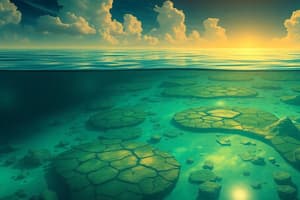Podcast
Questions and Answers
Critically evaluate the claim that dead zones are solely attributable to human activity, considering the role of natural upwelling and provide mechanisms by which each contributes to the formation of hypoxic conditions.
Critically evaluate the claim that dead zones are solely attributable to human activity, considering the role of natural upwelling and provide mechanisms by which each contributes to the formation of hypoxic conditions.
While human activities like fertilizer runoff exacerbate dead zones, natural upwelling also contributes by bringing nutrient-rich waters to the surface, fueling algal blooms. Both lead to oxygen depletion upon decomposition.
Formulate a comprehensive strategy that integrates both in situ and ex situ bioremediation techniques to address a hypothetical site contaminated with a recalcitrant and complex mixture of pollutants, detailing the specific conditions, advantages, and limitations of each approach within your integrated plan.
Formulate a comprehensive strategy that integrates both in situ and ex situ bioremediation techniques to address a hypothetical site contaminated with a recalcitrant and complex mixture of pollutants, detailing the specific conditions, advantages, and limitations of each approach within your integrated plan.
An integrated strategy could use in situ bioventing to stimulate initial degradation, followed by ex situ land farming to further degrade persistent compounds. The advantage is enhanced degradation, but limitations include the cost and time required for each step.
Analyze the implications of classifying air pollutants based on their persistence, origin, and biodegradability, and correlate these classifications with their long-term environmental and health impacts.
Analyze the implications of classifying air pollutants based on their persistence, origin, and biodegradability, and correlate these classifications with their long-term environmental and health impacts.
Persistence determines long-term environmental accumulation, origin informs source control strategies, and biodegradability dictates the pollutant's residence time and potential for natural attenuation.
Devise an advanced integrated assessment model for particulate matter (PM) pollution, incorporating source apportionment, atmospheric transport modeling, and health impact assessment to evaluate the effectiveness of various mitigation strategies on public health outcomes.
Devise an advanced integrated assessment model for particulate matter (PM) pollution, incorporating source apportionment, atmospheric transport modeling, and health impact assessment to evaluate the effectiveness of various mitigation strategies on public health outcomes.
Critically discuss the limitations of current regulatory frameworks in addressing the cumulative impacts of multiple air pollutants, particularly in the context of synergistic effects and vulnerable populations.
Critically discuss the limitations of current regulatory frameworks in addressing the cumulative impacts of multiple air pollutants, particularly in the context of synergistic effects and vulnerable populations.
Evaluate the trade-offs between the beneficial uses of fly ash, such as in cement manufacturing and road construction, and the potential environmental risks associated with its heavy metal content and leaching potential, proposing strategies to minimize these risks.
Evaluate the trade-offs between the beneficial uses of fly ash, such as in cement manufacturing and road construction, and the potential environmental risks associated with its heavy metal content and leaching potential, proposing strategies to minimize these risks.
Propose a novel electrochemical method for selectively removing fluoride ions from industrial wastewater while simultaneously generating value-added products, such as hydrogen gas or metal fluorides, thereby promoting a circular economy approach to fluoride pollution control.
Propose a novel electrochemical method for selectively removing fluoride ions from industrial wastewater while simultaneously generating value-added products, such as hydrogen gas or metal fluorides, thereby promoting a circular economy approach to fluoride pollution control.
Elaborate on the molecular mechanisms through which specific pollutants, such as nitrates and phosphates, disrupt aquatic ecosystems, leading to eutrophication and subsequent oxygen depletion, detailing the signaling pathways and gene expression changes involved.
Elaborate on the molecular mechanisms through which specific pollutants, such as nitrates and phosphates, disrupt aquatic ecosystems, leading to eutrophication and subsequent oxygen depletion, detailing the signaling pathways and gene expression changes involved.
Design an integrated risk assessment framework for emerging water pollutants, such as microplastics and pharmaceuticals, considering their sources, transport, transformation, exposure pathways, and ecological and human health effects, while addressing the uncertainties and data gaps associated with these contaminants.
Design an integrated risk assessment framework for emerging water pollutants, such as microplastics and pharmaceuticals, considering their sources, transport, transformation, exposure pathways, and ecological and human health effects, while addressing the uncertainties and data gaps associated with these contaminants.
Critically assess the efficacy of current water treatment technologies in removing persistent organic pollutants (POPs) and endocrine-disrupting compounds (EDCs), proposing alternative treatment strategies based on advanced oxidation processes, membrane bioreactors, or bioaugmentation techniques.
Critically assess the efficacy of current water treatment technologies in removing persistent organic pollutants (POPs) and endocrine-disrupting compounds (EDCs), proposing alternative treatment strategies based on advanced oxidation processes, membrane bioreactors, or bioaugmentation techniques.
Develop a comprehensive model to predict the dispersion and fate of oil spills in diverse marine environments, accounting for factors such as weather conditions, ocean currents, oil composition, and the effectiveness of various cleanup strategies, including booms, skimmers, and dispersants.
Develop a comprehensive model to predict the dispersion and fate of oil spills in diverse marine environments, accounting for factors such as weather conditions, ocean currents, oil composition, and the effectiveness of various cleanup strategies, including booms, skimmers, and dispersants.
Design a novel bio-catalytic system for the remediation of oil spills, utilizing genetically modified microorganisms to enhance biodegradation rates and produce environmentally friendly byproducts, such as biosurfactants or biopolymers.
Design a novel bio-catalytic system for the remediation of oil spills, utilizing genetically modified microorganisms to enhance biodegradation rates and produce environmentally friendly byproducts, such as biosurfactants or biopolymers.
Formulate a holistic watershed management plan that integrates land use planning, agricultural best management practices, and riparian buffer zones to minimize non-point source pollution and protect water quality in a vulnerable river basin.
Formulate a holistic watershed management plan that integrates land use planning, agricultural best management practices, and riparian buffer zones to minimize non-point source pollution and protect water quality in a vulnerable river basin.
Synthesize a novel material that acts as a combined adsorbent and photocatalyst for the simultaneous removal of heavy metals and organic pollutants from contaminated water sources, leveraging synergistic effects between adsorption and photocatalysis to enhance treatment efficiency.
Synthesize a novel material that acts as a combined adsorbent and photocatalyst for the simultaneous removal of heavy metals and organic pollutants from contaminated water sources, leveraging synergistic effects between adsorption and photocatalysis to enhance treatment efficiency.
Compare and contrast the effectiveness of centralized versus decentralized wastewater treatment systems in urban environments, considering factors such as infrastructure costs, energy consumption, nutrient recovery potential, and the ability to adapt to future challenges like climate change and population growth.
Compare and contrast the effectiveness of centralized versus decentralized wastewater treatment systems in urban environments, considering factors such as infrastructure costs, energy consumption, nutrient recovery potential, and the ability to adapt to future challenges like climate change and population growth.
Analyze the economic and social implications of stricter environmental regulations on industries, such as mining and agriculture, and propose policy mechanisms to mitigate negative impacts while promoting sustainable practices and innovation.
Analyze the economic and social implications of stricter environmental regulations on industries, such as mining and agriculture, and propose policy mechanisms to mitigate negative impacts while promoting sustainable practices and innovation.
Design an intelligent monitoring system that integrates real-time sensors, data analytics, and machine learning to detect and predict pollution events in complex environmental systems, enabling proactive management and rapid response.
Design an intelligent monitoring system that integrates real-time sensors, data analytics, and machine learning to detect and predict pollution events in complex environmental systems, enabling proactive management and rapid response.
Hypothesize how climate change-induced alterations in precipitation patterns, temperature, and sea level rise will exacerbate existing water pollution problems, and propose adaptation strategies to enhance the resilience of water resource management systems.
Hypothesize how climate change-induced alterations in precipitation patterns, temperature, and sea level rise will exacerbate existing water pollution problems, and propose adaptation strategies to enhance the resilience of water resource management systems.
Formulate a comprehensive life cycle assessment (LCA) to compare the environmental footprint of different energy sources (e.g., fossil fuels, nuclear, renewables), considering all stages from resource extraction to waste disposal, and identify opportunities for minimizing environmental impacts.
Formulate a comprehensive life cycle assessment (LCA) to compare the environmental footprint of different energy sources (e.g., fossil fuels, nuclear, renewables), considering all stages from resource extraction to waste disposal, and identify opportunities for minimizing environmental impacts.
Critically evaluate the effectiveness of carbon capture and storage (CCS) technologies in mitigating climate change, considering factors such as energy requirements, storage capacity, leakage risks, and the potential for alternative carbon utilization pathways.
Critically evaluate the effectiveness of carbon capture and storage (CCS) technologies in mitigating climate change, considering factors such as energy requirements, storage capacity, leakage risks, and the potential for alternative carbon utilization pathways.
Design a sustainable urban drainage system (SUDS) that integrates green infrastructure, such as green roofs, rain gardens, and permeable pavements, to manage stormwater runoff, reduce flooding, and enhance the ecological functions of urban landscapes.
Design a sustainable urban drainage system (SUDS) that integrates green infrastructure, such as green roofs, rain gardens, and permeable pavements, to manage stormwater runoff, reduce flooding, and enhance the ecological functions of urban landscapes.
Elaborate on the ethical considerations surrounding environmental pollution, including issues of environmental justice, intergenerational equity, and the rights of nature, and propose principles for guiding policy decisions that promote a more just and sustainable future.
Elaborate on the ethical considerations surrounding environmental pollution, including issues of environmental justice, intergenerational equity, and the rights of nature, and propose principles for guiding policy decisions that promote a more just and sustainable future.
Develop an internationally binding agreement aimed at mitigating marine plastic pollution, addressing issues such as production, consumption, waste management, and transboundary movement of plastic waste, while ensuring compliance and enforcement mechanisms.
Develop an internationally binding agreement aimed at mitigating marine plastic pollution, addressing issues such as production, consumption, waste management, and transboundary movement of plastic waste, while ensuring compliance and enforcement mechanisms.
Investigate the complex interplay between human activities and environmental degradation in a specific region, conducting an in-depth analysis of the social, economic, and ecological factors that contribute to the problem, and proposing integrated solutions that address the root causes and promote sustainable development.
Investigate the complex interplay between human activities and environmental degradation in a specific region, conducting an in-depth analysis of the social, economic, and ecological factors that contribute to the problem, and proposing integrated solutions that address the root causes and promote sustainable development.
Propose a radical new framework based on quantum computing that will allow accurate modeling of climate change 100 years into the future accounting for all major variables and give second by second feedback on the exact implications of every human generated action, what would this framework be, and what would be the barriers to prevent weaponization of this knowledge to benefit a select group of individuals?
Propose a radical new framework based on quantum computing that will allow accurate modeling of climate change 100 years into the future accounting for all major variables and give second by second feedback on the exact implications of every human generated action, what would this framework be, and what would be the barriers to prevent weaponization of this knowledge to benefit a select group of individuals?
Flashcards
Dead Zones
Dead Zones
Areas in the ocean with very low oxygen concentration, sometimes called biological deserts.
Bioremediation
Bioremediation
Uses microorganisms (bacteria and fungi) to degrade environmental contaminants into less toxic forms.
In-situ bioremediation
In-situ bioremediation
Bioremediation done at the site of contamination
Biosparging
Biosparging
Signup and view all the flashcards
Bioaugmentation
Bioaugmentation
Signup and view all the flashcards
Ex-situ bioremediation
Ex-situ bioremediation
Signup and view all the flashcards
Air pollution
Air pollution
Signup and view all the flashcards
Primary pollutants
Primary pollutants
Signup and view all the flashcards
Secondary pollutants
Secondary pollutants
Signup and view all the flashcards
Biodegradable pollutants
Biodegradable pollutants
Signup and view all the flashcards
Non-biodegradable pollutants
Non-biodegradable pollutants
Signup and view all the flashcards
Natural pollutants
Natural pollutants
Signup and view all the flashcards
Anthropogenic pollutants
Anthropogenic pollutants
Signup and view all the flashcards
Particulate pollutants
Particulate pollutants
Signup and view all the flashcards
PM2.5
PM2.5
Signup and view all the flashcards
Fly ash
Fly ash
Signup and view all the flashcards
Primary water treatment
Primary water treatment
Signup and view all the flashcards
Sedimentation
Sedimentation
Signup and view all the flashcards
Softening
Softening
Signup and view all the flashcards
Disinfection
Disinfection
Signup and view all the flashcards
Fertilisers
Fertilisers
Signup and view all the flashcards
Thermal pollution
Thermal pollution
Signup and view all the flashcards
Oil spills
Oil spills
Signup and view all the flashcards
Oil booms
Oil booms
Signup and view all the flashcards
Waste water
Waste water
Signup and view all the flashcards
Study Notes
- Dead zones are biological deserts or hypoxic zones in the ocean with very low oxygen concentrations.
- They emerge when there is an influx of excess chemical nutrients that spur algae growth.
- Dead zones usually occur 200-800 meters below the saltwater layer
- Hypoxic zones can occur naturally due to the upwelling of excess nutrients.
- Human activity can also create or enhance dead zones.
- Dead zones are detrimental to animal life, with organisms dying or migrating away.
How Dead Zones Form
- Fertilizers, sewage, and nutrients flow down rivers into the sea.
- These nutrients stimulate massive algae blooms.
- Plankton and algae die, sink, and decompose, using up oxygen.
- The area becomes starved of oxygen, and fish avoid the area.
Bioremediation
- Uses microorganisms like bacteria and fungi to degrade environmental contaminants into less toxic forms.
- Microorganisms can be specifically designed for bioremediation using genetic engineering.
In-Situ Bioremediation
- Occurs at the contaminated site
- Bioventing: Supply of nutrients through wells to contaminated soil to stimulate bacteria growth.
- Biosparging: Injection of air under pressure below the water table to increase groundwater oxygen concentrations and enhance bacteria degradation of contaminants.
- Bioaugmentation: Importing microorganisms to a contaminated site to enhance the degradation process.
Ex-Situ Bioremediation
- Involves removing contaminated material for treatment elsewhere.
- Land farming: Contaminated soil is excavated, spread, and periodically tilled until pollutants are degraded.
- The goal is to stimulate indigenous biodegradative microorganisms and facilitate their aerobic degradation of contaminants
- Bioreactors: Processing contaminated solid material (soil, sediment, sludge) or water through an engineered containment system.
- Composting: Nature's recycling of decomposed organic materials into soil.
Air Pollutants
- Air pollution refers to undesirable changes in the physical and chemical constituents of the air due to human activities.
Sources of Air Pollutants
- Primary pollutants: Direct emission into the atmosphere.
- Examples: CO, SO₂, NOx, PM
- Secondary pollutants: Result from reactions with atmospheric pollutants.
- Examples: Ozone, PAN
Mode of Release
- Indoor sources: Cooking, smoking, air conditioning
- Examples: CO, CO₂, VOCs
- Outdoor sources: Industrial processes, transportation
- Examples: PM, CO, VOCs
Chemical Composition
- Particulate matter: Solid or liquid aerosols.
- Examples: PM2.5, PM10
- Gaseous: Miscible with air in vapor form.
- Examples: SOx, Ozone, NOx, CO
Basis of Persistence
- Primary pollutants persist in their original form, like DDT or plastic.
- Secondary pollutants form through interactions, like Peroxyacetyl Nitrate (PAN) from nitrogen oxides and hydrocarbons.
Basis of Existence in Nature
- Quantitative pollutants occur naturally and become pollutants when exceeding a threshold.
- Examples: Carbon Dioxide, Nitrogen Oxide.
- Qualitative pollutants are man-made and don't occur naturally.
- Examples: Fungicides, herbicides, DDT.
Basis of Biodegradability
- Biodegradable pollutants are waste products degraded by natural microbial action, like sewage.
- Non-biodegradable pollutants don't decompose naturally, like plastics and polythene bags.
Basis of Origin
- Natural pollutants are released during natural processes, such as volcanic eruptions and forest fires.
- Anthropogenic pollutants are released during human activities, such as CO₂ emissions from burning fossil fuels.
Natural Sources of Air Pollution
- Ash from burning volcanoes
- Dust from storms
- Forest fires
- Pollen grains from flowers
Human Sources of Air Pollution
- Power stations release CO₂ from coal or crude oil use.
- Furnaces release pollutants from coal, dung, firewood, and kerosene use.
- Steam engines release CO₂.
- Motor and internal combustion engines release pollutants from petrol, diesel, and kerosene.
- Households release pollutants from vegetable oils, kerosene, and coal use.
- Sewers and domestic drains release foul gases.
- Pesticide residues are also a source.
- Agriculture emits pollutants.
Particulate Pollutants
- Suspended matter in the air, like dust and soot
- Major sources: Industries, vehicles, power plants, construction, oil refineries, railways, marketplaces
- PM10: Inhalable particles with diameters generally 10 micrometers or smaller.
- PM2.5: Fine inhalable particles with diameters generally 2.5 micrometers or smaller.
Fly Ash
- End product of combustion during power generation in coal-based thermal power plants.
- Consists of silica, alumina, oxides of iron, calcium, magnesium, and toxic heavy metals.
- Used in manufacturing Portland Cement, bricks/blocks/tiles, road embankment construction,etc
- ASH TRACK Mobile App facilitates better management of fly ash for thermal power plants.
Fluorides
- Sources: Aluminum, steel, electrochemical plants, blast furnaces, brick kilns, coal combustion
- Impact: Fluoride particles damage vegetation and cause fluorosis in cattle.
Water Pollutants
- Pathogens: Sewage, human and animal wastes
- Effects: Deplete oxygen and cause waterborne diseases
- Organic pollutants: Oil and grease, pesticides, plastics, detergents
- Effects: disrupt marine life and can be toxic
- Inorganic pollutants: fertilizers
- Effects: eutrophication
- Radioactive material: natural sources, uranium mining
- Effects: cancer and genetic defects
- Sediments: runoff from construction
- Affects water quality
Water Pollution Control Measures
- Primary treatment: sedimentation, coagulation, and filtration.
- Secondary treatment: removing calcium and magnesium from hard waters, aeration.
- Tertiary treatment: disinfection using chlorine or other methods.
Primary Treatment
- Sedimentation: Allowing polluted water to settle so silt and clay settle.
- Coagulation: Adding chemicals like potash alum to combine fine particles into larger ones for easier removal.
- Filtration: Passing water through sand, coal, or fibrous materials to filter out suspended particles.
Secondary Treatment
- Softening: Removing undesirable cations of calcium and magnesium from hard waters.
- Aeration: Exposing soft water to air to add oxygen and encourage organic matter decomposition.
Tertiary Treatment
- Disinfection: Commonly uses chlorine to kill bacteria.
- Other methods of disinfection include ultraviolet radiation, ozone gas treatment, or reverse osmosis.
Oil Spills
- Skimmers: Physically remove oil by separating it from water.
- Sorbents: Absorb oil from the surface
- Chemical surfactants: Can be used to associate oil into smaller particles to accelerate their dispersion.
- Bioremediation: Biological agents speed up natural biodegradation.
- Related Legislation – No law covering oil spill as such and its consequential environmental damage in India.
- India ratified the International Convention on Civil Liability for Bunker Oil Pollution Damage in 2015.
Heavy Metals in Water
- Copper: Fertilizers, tanning, and photovoltaic cells.
- Zinc: Soldering, cosmetics, and pigments.
- Silver: Refining of copper jewelry and electroplating industries.
- Chromium: Leather industry and tanning industries
- Arsenic: Wooden electricity poles, pesticides, and fertilizers.
- Mercury: Combustion of coal and waste incineration.
- Cadmium: Paints, batteries, and plastics
- Lead: PVC pipes and recycled lead paints.
Agricultural Sources as Water Pollutants
- Fertilizers containing nitrogen, phosphorus, and potassium.
- Pesticides including chlorinated hydrocarbons and organophosphates
- Animal excreta.
- Excess nitrate in drinking water reacts with haemoglobin and impairs oxygen transport
- High levels of nitrates may form carcinogens.
Thermal Pollution
- Occurs from thermal power plants releasing hot water which decreases dissolved oxygen in the water.
Marine Pollution
- Includes coastal city sewage, garbage disposal, and navigational discharge of oil.
Oil Spills
- Refers to uncontrolled release of crude oil into the environment and water
- Is a major environmental problem resulting from petroleum exploration and transport
- Oil negatively impacts on aquatic life
- Oil toxicity: It contains toxic substances that cause heart problems, and immune system effects
- Methods to clean: Use oil blooms to stop from spreading
Main Sources of Water Pollution
- Community waste water consists of human and animal waste
- Industrial waste discharges inorganic pollutants
Studying That Suits You
Use AI to generate personalized quizzes and flashcards to suit your learning preferences.




